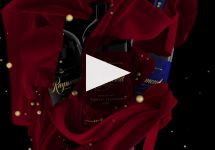Raymond Reserve Selection Cabernet Sauvignon (375ML half-bottle) 2018
- Decanter
-
Robert
Parker -
Wine
Spectator -
Wilfred
Wong -
Jeb
Dunnuck



Product Details
Your Rating
Somm Note
Winemaker Notes
This Cabernet Sauvignon opens with a beautiful bouquet of blackcurrants, espresso, and notes of violet. An array of dense dark fruit flavors of rhubarb, dark cherry, and blackberries are layered with blackcurrants, clove, and orange peel. This is a full bodied and structured wine with well-integrated and supple tannins and a richly textured finish that coats the palate.
Professional Ratings
-
Decanter
Having spent 19 months in 37% new French oak, this Raymond Reserve includes grapes harvested from Oakville, Rutherford, and St. Helena and delivers a potent glassful of voluptuous spice-dusted blackberry fruit, a hint of caramel and cocoa nibs. It’s full-bodied and mouth-filling revealing layers of silken black fruit that rushes over the palate redolent of blackberry jam, blueberry compote, and raspberry coulis. Flashy, succulent oak spices tinged with dark chocolate underscored by satiny tannins make for easy drinking. An enduring sweet finish beckons another sip. This is Napa hedonism wrapped in a characteristically Boisset flashy package with a satiny-textured label that rather accurately teases out the kind of texture you could expect from this Cabernet-dominant blend.
-
Robert Parker's Wine Advocate
The 2018 Cabernet Sauvignon Napa Valley Reserve is composed of 94% Cabernet Sauvignon, 5% Petit Verdot and 1% Cabernet Franc, coming from more than 20 different sites, with 29% coming from estate vineyards in St. Helena and Rutherford. It was aged in French oak barrels, 37% new. Deep garnet-purple colored, it rocks up with ready-for-business scents of blackcurrant pastilles, redcurrant jelly and Morello cherries with hints of dried Provence herbs, pencil shavings and dark chocolate. Full-bodied, the palate is jam-packed with crunchy black fruits, supported by firm, grainy tannins and bold freshness, finishing long and savor
-
Wine Spectator
Ripe and welcoming, with waves of red currant preserves and plum sauce rolling through, wrapped with red licorice and infused with a fruitcake note on the finish. Features a lightly toasty frame that lets the fruit hold center stage.
-
Wilfred Wong of Wine.com
COMMENTARY: The 2018 Raymond Reserve Selection Cabernet Sauvignon is well-built, persistent, and nicely textured. TASTING NOTES: This wine offers aromas and flavors of black fruit and oak. Pair it with a juicy, grilled ribeye. (Tasted: November 10, 2020, San Francisco, CA)
-
Jeb Dunnuck
Another outstanding wine, the 2018 Cabernet Sauvignon Napa Valley Reserve comes from over 20 different sites and was brought up in 37% new French oak. Redcurrants, leafy tobacco, and spice notes define the bouquet, and it’s lush, fruit-loaded, and ready to go. Enjoy bottles any time over the coming 7-8 years or so. I wouldn’t be surprised to see it evolve longer.
Other Vintages
2020-
Wine
Enthusiast -
Wine
Spectator
-
Jeb
Dunnuck -
James
Suckling -
Robert
Parker
-
James
Suckling -
Robert
Parker -
Wilfred
Wong -
Wine
Enthusiast -
Jeb
Dunnuck
-
Tasting
Panel -
Jeb
Dunnuck -
James
Suckling -
Robert
Parker -
Wine
Enthusiast -
Wine &
Spirits -
Wilfred
Wong
- Decanter
-
Wine
Spectator -
Jeb
Dunnuck -
Wine &
Spirits -
James
Suckling -
Robert
Parker -
Wine
Enthusiast
-
Robert
Parker -
Wilfred
Wong -
Wine
Enthusiast -
Wine
Spectator
-
Wine
Enthusiast
-
Wine &
Spirits
-
Wine
Enthusiast
-
Wine
Enthusiast
-
Wine
Enthusiast
-
Wine
Enthusiast
-
Wine
Enthusiast
-
Wine
Enthusiast
-
Wine
Enthusiast
-
Wine
Enthusiast
-
Wine
Enthusiast
-
Wine
Spectator
-
Wine
Spectator
-
Wine
Spectator
-
Wine
Spectator
-
Wine
Spectator









Raymond Vineyards, founded in 1970, is one of the Napa Valley’s pioneers and great estates. Arriving to Napa in 1933, the Raymond family became deeply connected to the valley’s winemaking origins. In 1970, they established a 90-acre estate in Rutherford that now comprises 300 acres in Rutherford, St. Helena and Jameson Canyon. Five generations of the Raymond family created a Napa icon, with an enduring reputation for elegant wines with a beautiful balance of finesse, power and complexity. Today, inspired by the vision of Proprietor Jean-Charles Boisset, Raymond is a dynamic destination dedicated to inspiring its guests’ passion for fine wine in an environment of exploration, creativity, and elegant whimsicality, where each in a series of diverse experiences progresses visitors into another world of discovery and exceptional wines. Further, Raymond’s Rutherford and St. Helena estate vineyards are certified organic and Biodynamic, and 100% of the winery’s power comes from renewable solar energy.

One of the most prestigious wines of the world capable of great power and grace, Napa Valley Cabernet is a leading force in the world of fine, famous, collectible red wine. Today the Napa Valley and Cabernet Sauvignon are so intrinsically linked that it is difficult to discuss one without the other. But it wasn’t until the 1970s that this marriage came to light; sudden international recognition rained upon Napa with the victory of the Stag’s Leap Wine Cellars 1973 Cabernet Sauvignon in the 1976 Judgement of Paris.
Cabernet Sauvignon undoubtedly dominates Napa Valley today, covering half of the land under vine, commanding the highest prices per ton and earning the most critical acclaim. Cabernet Sauvignon’s structure, acidity, capacity to thrive in multiple environs and ability to express nuances of vintage make it perfect for Napa Valley where incredible soil and geographical diversity are found and the climate is perfect for grape growing. Within the Napa Valley lie many smaller sub-AVAs that express specific characteristics based on situation, slope and soil—as a perfect example, Rutherford’s famous dust or Stags Leap District's tart cherry flavors.
